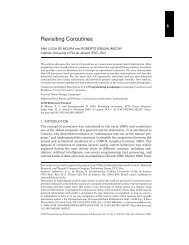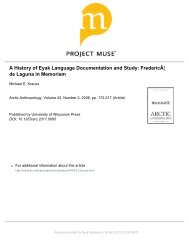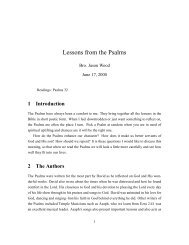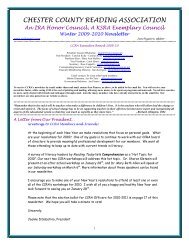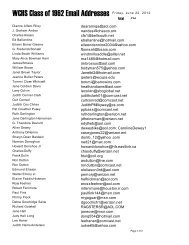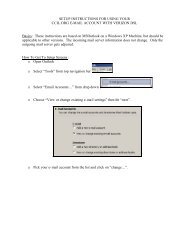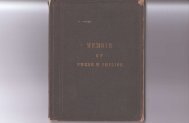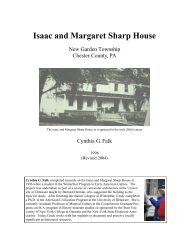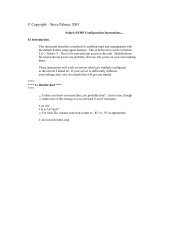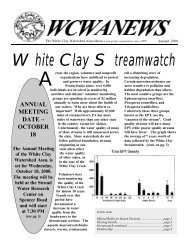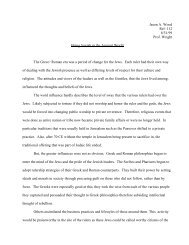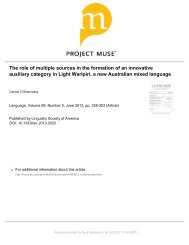Create successful ePaper yourself
Turn your PDF publications into a flip-book with our unique Google optimized e-Paper software.
were based on acoustic resonances. The consonant<br />
symbols occupy one or more of three vertically<br />
aligned areas and are made up of two basic parts,<br />
one showing place of articulation and the other manner<br />
of articulation. A further part is particularly interesting<br />
in its attempt to indicate states of the glottis<br />
other than ‘vibrating’ – open, narrowed, closed,<br />
creaky, and what Brücke called ‘hard resonance’ and<br />
‘soft resonance.’ The vowels occupy only the middle<br />
of the three areas, so that they stand out clearly.<br />
Diacritics are provided to indicate accent, duration,<br />
and types of juncture. Carl Merkel (1812–1876)<br />
also devised a non-Roman alphabet (Anatomie und<br />
Physiologie des menschlichen Stimm-und Sprachorgans,<br />
1857; revised edition, 1866), but, like Brücke’s<br />
alphabet, it is extremely difficult to read, and neither<br />
system attained any success. Both Brücke and Merkel<br />
were familiar with only a small range of languages<br />
and were concerned primarily to show the total capacities<br />
of the human vocal organs in the production of<br />
sounds.<br />
Moritz Thausing (1838–1884), in Das natiirliche<br />
Lautsystem der menschlichen Sprache (1863), based<br />
his system on a Naturlaut ‘natural sound’ represented<br />
by the vowel , and 21 other sounds, which diverged<br />
from in three different directions (seven<br />
on each path), like a three-sided pyramid. His notation<br />
used a musical staff of four lines and three<br />
spaces, thus accommodating the seven grades of<br />
sounds as notes on the staff. Each of the three sets<br />
of seven had a special note shape to distinguish it.<br />
Intermediate sounds were shown by modifiers.<br />
Thausing believed this was preferable to Brücke’s<br />
scheme in that the symbols were not iconic, and so<br />
could be used for sounds for which formation was not<br />
fully understood.<br />
Felix Du Bois Reymond (1782–1865) was stimulated<br />
by the schemes put forward by Brücke and<br />
Lepsius to complete a scheme of his own (Kadmus,<br />
1862), which he had sketched out earlier. It was<br />
Roman based, but, unusually, attempted to combine<br />
this with an iconic approach. So, for instance, all the<br />
voiceless consonants had symbols that extend below<br />
the ‘middle area’ (mittlere Bahn), unlike the voiced<br />
ones: and already conform to this principle,<br />
and to continue it, Reymond proposed, for example,<br />
that the symbol should replace as the<br />
voiceless equivalent of . Like Brücke, he confined<br />
the vowel symbols to the ‘middle area.’ In spite of a<br />
good phonetic basis outlined in his book, the scheme<br />
failed to become established.<br />
Bell’s Visible Speech<br />
Alexander Melville Bell was the son of an elocution<br />
teacher, and in due course became his father’s<br />
<strong>Phonetic</strong> <strong>Transcription</strong>: <strong>History</strong> 405<br />
principal assistant. Between the years 1843 and<br />
1870, he lectured in the universities of Edinburgh<br />
and London, after which he emigrated to Canada<br />
and continued his teaching there. In 1864, he gave<br />
public demonstrations of his new scheme for recording<br />
speech in writing, and in 1867 the system was<br />
published under the title Visible speech, the science of<br />
universal alphabetics. It was not (at least avowedly)<br />
intended to be a new spelling system, but rather to<br />
assist children in learning to read, and to provide ‘‘a<br />
sound bridge from language to language.’’ Bell was<br />
unsuccessful in attempts to persuade the British government<br />
to give him funds to support the system, but<br />
continued to use it for his own purpose in teaching,<br />
and claimed that it was ‘‘perfect for all its purposes.’’<br />
The symbols he used were iconic, intended to signify<br />
the vocal organs involved in the production of the<br />
sound concerned. For instance, the open vocal cords<br />
are shown by , which represents [h]. The consonant<br />
symbols are based on a sagittal diagram of the<br />
head facing right. The shape < > represents a continuant<br />
(shown by the fact that there is a gap to the<br />
right) with a constriction at the back (i.e., [x]), whereas<br />
< > represents a constriction at the front of the<br />
vocal tract, namely [y¨]. The same symbol with the gap<br />
facing upward represents dental [y], and with the<br />
gap facing downward, palatal [ç]. The remaining<br />
consonant symbols have similar iconic relationships,<br />
with modifiers to show complete closure (a bar across<br />
the gap), nasality (a different bar), voicing, etc. The<br />
vowel symbols are based on a vertical line, with<br />
hooks at the top (close vowels), bottom (open<br />
vowels), or both (mid vowels), facing left for back<br />
vowels, right for front vowels, and in both directions<br />
for the so-called ‘mixed’ or central vowels. Rounding<br />
is shown by a horizontal bar through the middle.<br />
Ellis, writing just before the full publication of<br />
Visible speech, admitted that his Palaeotype was<br />
‘‘far less complete’’ than Bell’s scheme. ‘‘However,<br />
that alphabet,’’ he said, ‘‘requires new types, which<br />
is always an inconvenience, though I believe that an<br />
entirely new system of letters, such as that of Mr. Bell,<br />
is indispensable for a complete solution of the problem.’’<br />
He pointed out also that many potential users<br />
‘‘are ill-qualified, without special training, to use a<br />
very refined instrument.’’ Iconic notations are certainly<br />
subject to the criticism that they may not be able to<br />
accommodate new sounds or new descriptive frameworks,<br />
and can never convey the exact nature of the<br />
sound symbolized. Bell’s symbols were much better<br />
in design than most alphabets of this kind are, but<br />
he faced the immense task of persuading people to<br />
adopt a system that looked very different from what<br />
they were used to seeing. The alphabet failed to find<br />
supporters outside the circle of his pupils.



